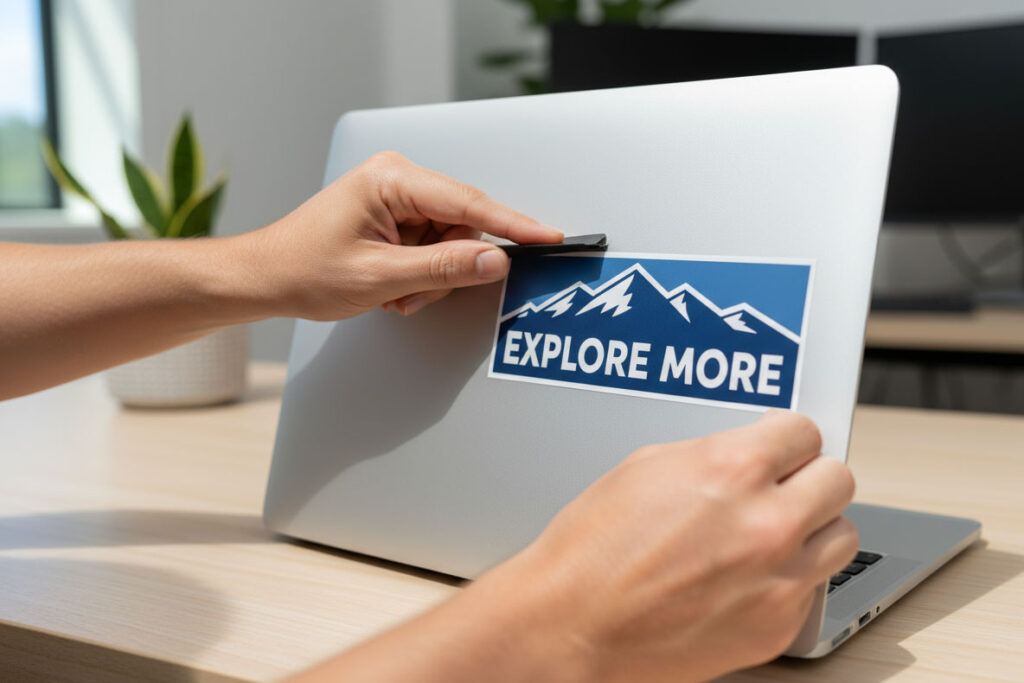Lightning Fast Turnaround!

Nothing ruins a great sticker faster than edges that start peeling up.
You invested in quality stickers. The colors pop exactly right and the design is perfect. Then three days later, the corners start lifting. A week after that, half the edge is flapping in the breeze. Eventually, your beautiful creation becomes litter on the ground, taking your investment with it.
This happens so often that many people think it’s just how stickers work. They don’t. Quality stickers applied correctly should stay put for years, not days. The difference between a sticker that lasts and one that fails almost always comes down to application technique, not the sticker itself.
At The Bumper Sticker, we’ve been helping businesses and individuals create custom stickers for decades. We’ve seen every possible application scenario, from scorching Arizona car bumpers to freezing Minnesota storefront windows. Through all of it, we’ve learned what makes stickers stick and what makes them fail.
The success of your sticker application is decided before the sticker even leaves its backing. The goal is to create a perfectly pristine surface, ensuring nothing can interfere with the adhesive’s bond.
The surface might look clean, but microscopic oils, dust, wax, and residue are the number one enemies of adhesion. You must create a surgically clean environment.
The ideal cleaning agent is isopropyl alcohol, also known as rubbing alcohol.
Apply a small amount of alcohol to a clean, lint free cloth (like a microfiber towel). Thoroughly wipe down the entire area where the sticker will be placed. The alcohol will break down any oils or residues without leaving a film of its own.
Do not use common glass cleaners or all-purpose soaps. Many of these products contain ammonia, scents, or moisturizers that leave behind an invisible film, which will actively prevent the sticker’s adhesive from bonding correctly.
Adhesive and moisture do not mix. The surface must be completely and totally dry.
After cleaning with alcohol, which evaporates quickly, use a separate dry, lint free cloth to wipe away any remaining moisture. To be absolutely certain, allow the surface to air dry for an additional five to ten minutes, especially in a humid environment. Rushing this step can trap a micro layer of moisture, leading to future failure.
This is designed for smooth, non-porous surfaces like glass, metal, finished wood, and smooth plastics. Applying stickers to heavily textured, porous, or flexible surfaces like unfinished wood, certain dashboards, or fabric will not yield a permanent bond.
This is the critical moment of the process. The goal here is to achieve a full, bubble-free bond between the adhesive and the surface. Do not simply peel the entire backing and slap the sticker on. This method invites air bubbles and creases.
Without removing the backing, place the sticker on the surface to determine its final position. For large graphics or precise placement, you can use small pieces of painter’s tape to create a hinge or alignment marks.
Lay the sticker face down on a clean, flat surface. Carefully peel the backing paper away from the center of the sticker, folding it back on itself. Alternatively, for larger stickers, peel back only the top inch or two of the backing paper.
Holding the sticker by its edges, carefully align it and press the newly exposed central portion of the adhesive firmly onto the surface. This creates a strong anchor point.
Using a plastic card (like a credit card) or a felt tipped squeegee, begin to smooth the sticker onto the surface. Start from the center where you made the anchor point and push outwards towards the edges with firm, overlapping strokes. This action systematically pushes any potential air bubbles out to the edges, rather than trapping them in the middle. As you work your way outwards, continue to slowly peel away the remaining backing paper.
Once the entire sticker is applied, perform one final pass with your squeegee, paying special attention to all the edges. Applying firm pressure around the entire perimeter ensures the most vulnerable part of the sticker has the strongest possible initial bond.
This final, often overlooked step is what locks in the longevity of your sticker. The adhesive on a quality vinyl sticker is pressure sensitive, but it also needs time to fully cure and form its maximum bond strength.
For the first 72 hours after application, the adhesive is still setting on a molecular level. During this crucial period, you must protect the sticker from extreme conditions.
Avoid washing the object, especially with high pressure water. Keep it out of extreme heat or cold. Do not pick at or test the edges. Simply let it be. This patience allows the adhesive to cure into a hard, permanent bond that will resist peeling for years.
For our businesses applying product labels or vehicle graphics, standardizing these rules is essential for brand consistency and protecting your investment. A peeling label on a product shelf or a lifting graphic on a company vehicle reflects poorly on your brand. Train your team on this process to ensure a professional finish every time.
Temperature plays a huge role. The ideal range for applying a vinyl sticker is between 50- and 90-degrees Fahrenheit (10 to 32 degrees Celsius). If it is too cold, the adhesive will become rigid and will not bond properly. If it is too hot, the adhesive can become overly gummy and the vinyl too pliable, making it difficult to handle.
The Central Anchor Maneuver is even more critical here. Start by applying the center of the sticker to the highest point of the curve. Then, use your thumb or squeegee to slowly press the sticker down, working your way outwards from the center in a smooth, rolling motion. For very complex curves, a little bit of heat from a hair dryer can make the vinyl more flexible, but use it sparingly and carefully to avoid stretching the design.
Unfortunately, no. The adhesive on a high-quality vinyl sticker is designed for a single, permanent application. Attempting to peel it off, even moments after application, will stretch the vinyl, compromise the adhesive, and almost certainly result in the sticker being ruined. This is why the positioning step is so important. Measure twice, apply once.
To remove an old vinyl sticker, gently warm it with a hair dryer. This will soften the adhesive. Then, use a plastic razor blade or your fingernail to lift one edge and slowly peel the sticker back on itself at a sharp angle. Any remaining residue can be safely removed with an adhesive remover like Goo Gone or by using rubbing alcohol and some patience. Always clean the surface afterward before applying your new sticker.
Clean isn’t always clean enough. Invisible residues from cleaning products, skin oils from handling, or atmospheric contamination can prevent proper adhesion. Always do a final wipe with isopropyl alcohol and avoid touching the cleaned surface before application. Also check application temperature; cold surfaces prevent adhesive from bonding properly even when clean.
Give adhesive at least 24 to 72 hours to fully cure before exposure to moisture or extreme conditions. While stickers might feel secure immediately after application, the adhesive continues forming bonds over time. Premature exposure to water, especially high pressure washing, can penetrate edges before the adhesive reaches full strength. For vehicle applications, wait a full 72 hours before car washes.
|
Uploaded
Failed
|
 |